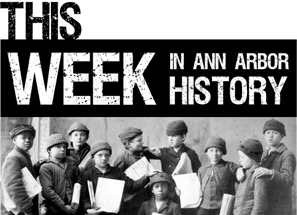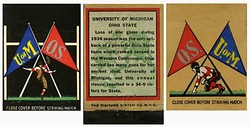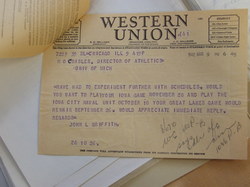Michigan vs. Ohio State: 1942 and "The Game" that wasn't
Editor's note: This Week in Ann Arbor History looks back at some notable moments from the city's past.
Since 1935, the Michigan-Ohio State football game has been a staple at the end of the Wolverines' regular season schedule, with only three exceptions: 1942, 1986 and 1998.
The 1986 and 1998 exceptions are easy enough to explain. Both games were against the University of Hawaii, a team it only makes sense to play at the end of the regular season in Hawaii.
Playing Hawaii in Ann Arbor would defeat the purpose of playing such an exotic opponent. But playing Hawaii in Honolulu to start the season isn't the best preparation for teams like Notre Dame and Penn State.
But the story of the 1942 season finale against Iowa is more complicated. As with every aspect of American life at the time, World War II played a pivotal role in shaping the Big Ten schedule in 1942.
After the Japanese attack on the U.S. naval base at Pearl Harbor on Dec. 7, 1941, Big Ten commissioner John L. Griffith put his energy into ensuring big time college football would continue even as America entered the bloodiest conflict in history.

On Dec. 8, 1941, the day after the Pearl Harbor attack, Griffith wrote a letter to Big Ten athletic directors noting his "intent...to indicate that the schools and colleges of America stand...ready and eager to adapt their athletic and physical educational programs to the best ends of national defense."
This was a time when the Big Ten was still the dominant conference. Griffith was concerned the war might curtail college football, so he launched a public relations campaign that tied it to the war effort directly.
Initially, the Big Ten offered to donate the profits of the 1942 season to the Army-Navy Relief Fund. The government declined the proposal, preferring instead that war bonds be sold at raffles during halftime.
The Big Ten schools then initiated physical hardening programs, requiring physical training for all able-bodied men on campus. Michigan's program, which required 4.5 hours a week of training — divided into 3 sections of 90 minutes apiece — was headed by football coach and first-year athletic director Fritz Crisler.
Michigan football has long picked up the slack for non-revenue sports. During World War II, football also paid for the physical hardening program, which prepared hundreds of Michigan men to serve their country in war.

The Michigan-Ohio State game has been a staple at the end of Michigan's regular season schedule since 1935 - with three exceptions.
Courtesy: Bentley Historical Library
As Crisler said to a reporter at the time, "Since (Pearl Harbor) the term 'physical fitness' has taken on new meaning for civilians and soldiers alike. Army and Navy authorities have reported that many recruits have been so soft and undeveloped physically that completion of basic training has been seriously delayed by necessary physical conditioning processes."
There was one last concession, and this one affected "The Game" directly: Two games were added to the 1942 schedule, with the extras played against service teams like the Iowa Seahawks and the Great Lakes Bluejackets —Â both of whom Michigan faced in 1942, going 1-1.
When it came to moving U-M vs. OSU from the end of the regular season schedule, the limited discussion focused on logistics, not how it would affect the tradition.
In a March 9, 1942, memo to Crisler, commissioner Griffith wrote: "Have had to further experiment with schedules. Would you want to play your Iowa game Nov. 28 and play the Iowa City naval unit Oct. 10?" Crisler wrote back the next day and agreed.

The Game that Wasn't: Big Ten commissioner John Griffith shoehorns two games into Michigan's 1942 schedule, including an Iowa game the week after Ohio State.
Courtesy: Bentley Historical Library
That the Ohio State game fell on Nov. 21, a week before Iowa was shoehorned into the schedule, never came up. Griffith's chief concern wasn't preserving the still-new tradition of the Michigan-Ohio State season finale — it was about ensuring the show would go on. He knew one season off could easily become several, depending on how long the war raged.
But Michigan's extended schedule didn't work out for the best. According to the Ann Arbor News, had the 1942 season ended after eight games like a normal season, Michigan would have rode out with a 32-20 victory over Notre Dame, a game so emotional that Al "Ox" Wistert's teammates carried the tackle off the field after his dominating performance.
Beat-up and unable to rally for a second straight rivalry game, Michigan fell 21-7 to the Ohio State Buckeyes in week nine, leaving no chance for a Big Ten title.
While fans and sportswriters weren't thrilled to come back for a game against the Iowa Hawkeyes, Fritz Crisler exhorted his players to finish the season with character.
Don Lund was a fullback on that 1942 team.
"Normally, this would be the end of our season," Lund recalled Crisler telling the team, as they hung their heads after the tough loss. "But this year we've got another game — let's take advantage of it."
The Wolverines did, dominating the Hawkeyes in a 28-14 victory to earn a ninth place finish nationally.
Ohio State, under the tutelage of the legendary Paul Brown, went on to win the first of its seven national championships.
James David Dickson can be reached at JamesDickson@AnnArbor.com.


Comments
James Dickson
Tue, Nov 23, 2010 : 3:59 p.m.
RudeJude: A number of players ended up serving. J.T. White, for instance, played on the Ohio State team that won the national championship in 1942, served at war, came back after as a Michigan Man and won the national championship with the 1947 "Mad Magicians" team, the only player to win national championships at both schools.
RudeJude
Tue, Nov 23, 2010 : 3:40 p.m.
Thanks for this piece of history, James. I feel foolish arguing about Coach Rodriguez's job security after reading this. It is hard to imagine Coach Rod or Dave Brandon leading a physical hardening program of today's Michigan student body like Fritz Crisler did in '42. I assume most, if not all, Big Ten's football players were considered "able-bodied." Were any drafted during this period?